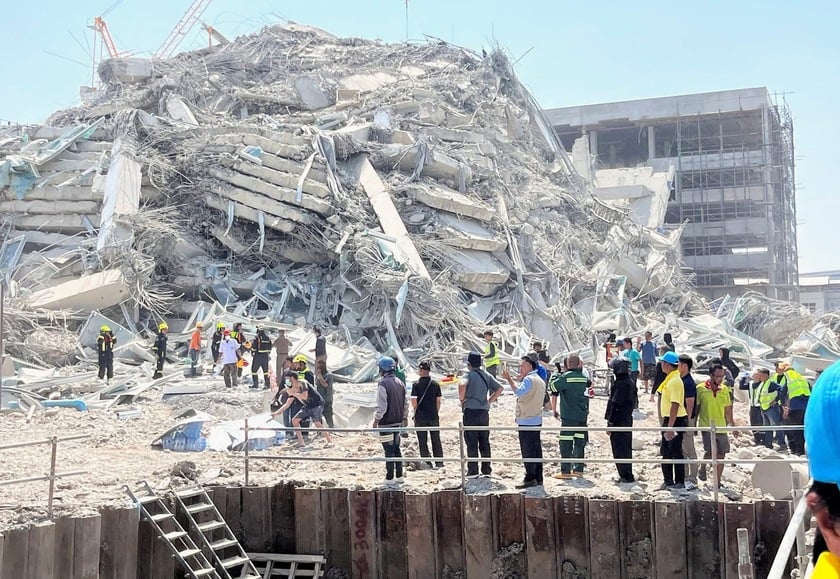At noon on March 28, a remarkable seismic event occurred, causing widespread tremors that could be clearly felt in many provinces and cities across Vietnam.
According to the Institute of Geophysics, at 13:20:57 (Hanoi time) on March 28, 2025, an earthquake of magnitude 7.3 occurred at the coordinates (21.71 degrees North latitude, 96.02 degrees East longitude), with a focal depth of about 10 km. The earthquake occurred in the Myanmar area. The Earthquake Information and Tsunami Warning Center - Institute of Earth Sciences is continuing to monitor this earthquake.

High-rise buildings in Bangkok are in ruins after the earthquake.
The US Geological Survey (USGS) website shows the earthquake as having a magnitude of 7.7. The countries affected include Bangladesh, India, Laos, Myanmar (Burma), Thailand and China.
Bloomberg said that a strong earthquake in Myanmar was clearly felt in Bangkok, Thailand, forcing people to move into the streets.
In Bangkok, the shaking caused an alarm to sound at around 1:30 p.m., forcing residents to evacuate high-rise buildings and hotels in central Bangkok.
There have been no reports of damage or casualties from the earthquake in Myanmar.
According to Xinhua News Agency, the China Earthquake Networks Center (CENC) measured the earthquake in Myanmar as strong as 7.9 on the Richter scale and the tremors could be felt in Yunnan, China.

At the time of the incident, there were about 50 workers working inside the building. Of them, 7 people managed to escape, while 43 people were still trapped.
From the capital Hanoi, the economic center of Ho Chi Minh City, to the coastal city of Da Nang, and even the northern mountainous provinces such as Son La, Dien Bien, Lai Chau, Hoa Binh, Thanh Hoa, Nghe An, people all felt the prolonged tremors. This phenomenon has caused a lot of anxiety and discussion in the community.

Many people in Vietnam rushed into the streets after the earthquake's aftershocks.

According to scientists, the epicenter of this earthquake was in central Myanmar, an area about 50km east of Monywa city. The United States Geological Survey (USGS) recorded the magnitude of the earthquake at 7.7 on the Richter scale. However, the Vietnam Earthquake Information and Tsunami Warning Center gave a different figure, confirming that the earthquake had a magnitude of 7.3. This difference may be due to differences in measurement methods and equipment used.

The magnitude of the earthquake, with its shallow epicenter, created a very wide area of influence, spreading seismic waves to many countries in the region. The power of this earthquake made the tremors felt at great distances, beyond national borders.
Many people in affected areas such as Hanoi shared the feeling of two tremors about 20 minutes apart, the first strongest one occurred at 13:20, lasting for a long time, causing doors, cabinets, furniture to collide, the angular amplitude of hanging objects fluctuated 15-20 degrees. The aftershocks were lighter.
According to many experts, many people living in areas with weak geological foundations, such as soft soil or clay, will feel the tremors more strongly than areas with strong geological foundations. Similarly, people living in high-rise buildings will also feel the shaking caused by earthquakes more clearly, because the structure of these buildings tends to amplify the vibrations.

The earthquake left many unfortunate consequences.
In 2012, Myanmar experienced a magnitude 6.8 earthquake in the Mandalay area, causing extensive damage. In 2016, the country suffered another magnitude 6.8 earthquake near Bagan, shaking many ancient temples.
However, the earthquake this afternoon (March 28) is the largest earthquake ever recorded in this country. On the moment scale, earthquakes with a magnitude of over 7.0 are classified as major earthquakes, causing serious destruction. This earthquake is slightly smaller in magnitude than the 2008 Sichuan (China) earthquake (7.9 magnitude) that claimed the lives of 70,000 people.



































